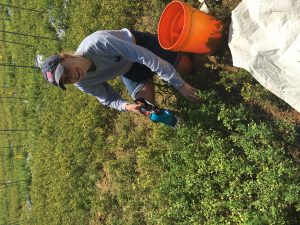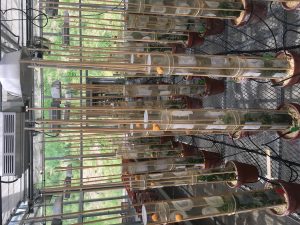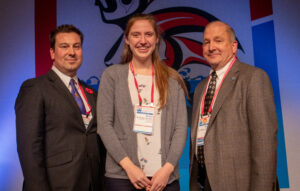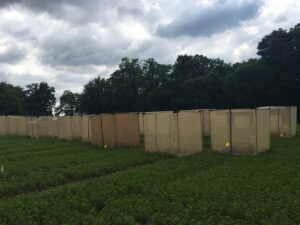Final report for GNE18-187
Project Information




Increased nitrogen yield and content of forage crops results in increased profitability for growers. To meet biological nitrogen demands, alfalfa (Medicago sativa) depends primarily on nitrogen fixation, which is a process that eliminates nitrogenous fertilizer application. However, various biotic stressors can disrupt nitrogen fixation in crops. Determining the effect of pest feeding on nitrogen fixation in alfalfa provides growers with critical information to maintain high forage quality despite high pest pressure. Potato leafhopper (PLH; Empoasca fabae) is an economically important pest of alfalfa that alters numerous physiological processes in plants and could also disturb nitrogen fixation. Here I present two main objectives to understand the effect of PLH feeding on nitrogen fixation in alfalfa. First, I examined nitrogen assimilation sources in alfalfa in response to PLH feeding in the field by comparing two types of alfalfa: one strain capable of nitrogen fixation and one that is not. The aim was to understand if alfalfa can compensate for nitrogen losses from PLH feeding by taking up soil nitrogen. Results from my field study showed reductions in percent nitrogen of shoots with leafhoppers present but increases in rates of nitrogen fixation, completely contrary to my predictions. Additionally, I studied the response of PLH-resistant and PLH-susceptible alfalfa cultivars to pest pressure in terms of nitrogen fixation. I determined which nitrogen source (atmospheric vs. soil) each cultivar relies on in response to PLH feeding and if PLH-resistant alfalfa can protect against nitrogen losses. Results from this study showed significant reductions in the percent nitrogen of alfalfa shoots when leafhoppers are introduced, regardless of the fertilizer treatment. Overall, my project determined how PLH feeding alters nitrogen fixation in alfalfa and assessed the effectiveness of using PLH-resistant varieties to reduce loss of nitrogen fixation for growers.
My research objectives are to:
1. Measure the effect of PLH injury on nitrogen fixation and soil nitrogen uptake in a field setting, and
2. Compare the response of resistant and susceptible alfalfa cultivars to PLH injury with regard to nitrogen fixation and soil nitrogen uptake.
The purpose of this project is to understand the effect of potato leafhopper (PLH; Empoasca fabae) feeding on nitrogen fixation in alfalfa (Medicago sativa). Nitrogen fixation by root-colonizing bacteria (Sinorhizobium) accounts for approximately 80% of the total nitrogen in alfalfa. Nitrogen is the main component of protein synthesis in alfalfa, and as a forage crop, growers receive premium prices for alfalfa high in crude protein. Any reductions in crude protein result in lower quality forage and economic loss for growers. Therefore, growers need to protect against losses to nitrogen fixation, which could come from increased pest pressure. Whether PLH, a key pest of alfalfa in the eastern US, alters nitrogen fixation has not been reported. PLH feeding significantly damages numerous physiological processes in alfalfa, such as reducing rates of photosynthesis and disrupting transport of nutrients from shoots to roots. Therefore, I hypothesize PLH feeding deters nutrient movement in alfalfa, disrupting nitrogen fixation and ultimately affecting forage quality and persistence of the perennial crop. Due to its importance, it is critical to understand factors that impair nitrogen fixation.
PLH feeding may impact nitrogen availability to crops in multiple ways. Hypothetically, in a worst-case scenario, PLH disrupts the ability of alfalfa to transport nitrogen from roots to shoots, and no amount of additional fertilizer will remediate the issue. However, PLH feeding specifically targets plant phloem, which may allow for nitrogen transport through xylem even under PLH pressure. In this scenario, alfalfa roots could compensate by absorbing larger quantities of soil nitrogen, increasing the need and cost of fertilizers for growers. Typically, growers do not apply any nitrogenous fertilizers to alfalfa but this may change under PLH pressure. If growers are unaware of the need for fertilizers, their alfalfa quality and yield could unknowingly decrease. Therefore, a need exists to understand the source of nitrogen utilized by alfalfa under substantial pest pressure and if alfalfa can compensate for PLH feeding with supplemental nitrogen sources.
Examining the impact of PLH feeding on nitrogen fixation helps to inform management decisions for growers. If resistant varieties protect alfalfa from reduced nitrogen fixation, growers can use this information to select appropriate varieties based on pest pressure. Furthermore, as a perennial crop, growers often keep stands of alfalfa for multiple growing seasons. If alfalfa faces intense PLH pressure prior to a given harvest, root nitrogen reserves may decrease, lessening available nitrogen in plants of subsequent harvests. Therefore, the effects of PLH feeding on nitrogen fixation could compound over time, reducing forage quality not only in one growing season but also future growing seasons. Additionally, growers often rotate to non-nitrogen-fixing crops, such as corn or wheat, after alfalfa. Growers anticipate these crops benefit from excess nitrogen in soils. However, reductions in nitrogen fixation could decrease soil health and ultimately diminish the success of future crop rotations. In essence, understanding altered nitrogen fixation in alfalfa under pest pressure is imperative for growers to maintain high levels of productivity.
Research
Objective 1: Measure the effect of PLH feeding on nitrogen fixation and soil nitrogen uptake in a field setting.
To measure the effect of PLH feeding on nitrogen fixation, I conducted a field experiment using caged alfalfa plants with and without PLH. Comparing plants with and without PLH identifies the specific effect PLH feeding has on nitrogen fixation. To determine whether PLH disrupts nitrogen fixation, I measured natural nitrogen isotope ratios (15-N/14-N) of alfalfa tissue to determine the source of nitrogen (14-N atmospheric vs. 15-N soil). The 14-N isotope accounts for approximately 99% of atmospheric nitrogen, whereas 15-N is derived primarily from organic material. Looking at 15-N/14-N ratios reveals if plants predominantly receive nitrogen from the atmosphere or not. For another treatment, I amended soils with 15-N fertilizer, which discerned if alfalfa adjusts its nitrogen sources from atmosphere to soil when disturbed by PLH feeding.
In addition to using isotope ratios to answer my question, I also used two types of ‘Saranac’ alfalfa: one is effective (normal type) and the other is ineffective (non-nitrogen fixing). PLH feeding affects numerous physiological processes in alfalfa, and ineffective alfalfa allowed me to determine if PLH feeding alters nitrogen assimilation in ways other than disrupting nitrogen fixation. Ineffective alfalfa still forms root nodules but these nodules are non-functional, which is evident by their coloration. Functional nodules are pink (due to the presence of leghemoglobin) and non-functional nodules are grey. Preliminary tests compared two effective and four ineffective types of ‘Saranac’ alfalfa and found comparable germination rates in the selected effective and ineffective types. Ineffective alfalfa served as a control in my experiment to explore if PLH feeding disrupts nitrogen fixation.
My field study was conducted at one experimental site over one field season. The alfalfa for this study was planted in August, 2017, at the Western Maryland Research and Education Center in Keedysville, MD. All treatments were replicated four times and arranged in a randomized complete block split plot design. Each trial (harvest) consisted of four main- and two subplot treatments. Main plots consisted of: 1) Effective alfalfa supplemented with 15-N, 2) Effective alfalfa without 15-N, 3) Ineffective alfalfa supplemented with 15-N, and 4) Ineffective alfalfa without 15-N. Subplot treatments included cages with PLH or cages without PLH. Fine mesh cages (2.5 m x 2.5 m) containing PLH receive economic threshold levels of PLH based on plant height at 14 days after harvest. There were a total of 16 main plots, each 6 m × 6 m, and two subplots per main plot.
A spring harvest of the entire field occurred in mid-May, 2018. Following this harvest, I flagged subplots and used spray paint on the soil surface around flags to mark subplot locations. I then used an organic insecticide to remove any PLH from subplots. After establishing subplots, I applied 15-N at a rate of 2.4 kg/ha to designated subplots. 15-N can persist for extensive periods of time in soil and should remain prevalent throughout my study. I then erected field cages at the flagged subplot locations. 14 days after harvest, I aspirated PLH into designated cages. To collect PLH for aspiration, I used a D-Vac on a small strip of alfalfa, which I maintained throughout the growing season at Keedysville.
After 35 days, cages were removed and I dug up 5 alfalfa plants at 15 cm deep in each plot to measure N components of roots, crowns, and shoots in the lab. I then used a Carter mower to harvest the area under each cage (2.5 m x 2.5 m). Harvest samples were used to determine forage yield. After completing my measurements, I mowed down the entire field and then used an organic insecticide on subplots and again erected cages. Aspiration of PLH into designated cages occurred 14 days after harvest. In the lab, a subsample of the harvest sample was dried at 60 Degrees Celsius for 2 days. I ground subsamples using a Cryomill (Retsch Mill) available at the University of Maryland Entomology Department. After I ground and weighed subsamples, I determined natural nitrogen isotope ratios (15-N/14-N). To do this, I took ground subsamples to the University of Maryland Geology Department for natural nitrogen isotope analysis using a Micromass/Elementar Isoprime mass spectrometer. I completed multiple harvests during the 2018 growing season, and I repeated the described procedure for each harvest. From these data, I used ANOVA to compare yield, nitrogen yields, and relative proportion of 15-N/14-N across all treatment combinations for each harvest. I analyzed each harvest individually due to the repeated measures from each experimental unit. Overall, I anticipated any negative effects induced by PLH feeding would compound over time, resulting in alfalfa with continually reduced nitrogen fixation throughout the growing season.
Objective 2: Compare the response of resistant and susceptible alfalfa cultivars to PLH injury with regard to nitrogen fixation and soil nitrogen uptake.
To learn if resistant alfalfa is a viable management tool in combating nitrogen losses from PLH feeding, I conducted a greenhouse experiment to compare nitrogen uptake in resistant and susceptible alfalfa. Seeds of a leafhopper-susceptible variety and a leafhopper-resistant variety were grown in standard potting mixture and allowed to germinate and develop for two weeks. At this early stage of development, nodules did not form and any nitrogen present in the potting mixture did not confound the study. After two weeks, seedlings were removed from the potting mixture. Seedling roots were washed in a Sinorhizobium (nitrogen fixing bacteria) inoculum and then three seedlings were transplanted into 10 cm ceramic pots filled with sand. At the conclusion of the experiment, sand facilitated separating root tissue from growth media. Pots were watered daily through a hydroponics set up, pausing watering once a week to add nitrogen-free Hoagland’s solution. Using this solution forces the plants to use the atmosphere instead of the soil as their source of nitrogen. After nine weeks of growth, the plants were cut back to 2.5 cm of stubble, simulating harvest in the field, and initiating experimental manipulation.
All treatments were replicated twelve times and arranged in a randomized complete block design along two greenhouse benches. Treatments represent all possible combinations of three factors: 1) susceptible or resistant variety, 2) sand amended with 15-N or not, and 3) PLH present or absent on plants. For PLH treatment, pots were covered with plastic cylindrical cages at 21-28 days after cutting. Half of the cages received 10 PLH and the other half did not. This time period represents when nitrogen fixation is most vulnerable to PLH injury. Additionally, I amended pots with 15-N (16 mg of 15-N labeled potassium nitrate diluted in 50 mL of water). For pots that did not receive 15-N amendments, I added 16 mg of potassium chloride diluted in 50 mL of water to balance the amount of potassium received by all plants (chloride is not a required nutrient and would not impact alfalfa growth). 35 days after cutting, plants will be separated from sand and divided into shoot, crown, and root portions. Tissues were dried in an oven at 60°C for two days, ground, and subject to nitrogen isotope analysis as previously described. ANOVA was used to compare the response of nitrogen fixation in resistant and susceptible alfalfa under pest pressure.
Objective 1: Results from June 2018
Results from my first harvest in June 2018 showed unanticipated results. When I introduced leafhoppers to field cages, regardless of the alfalfa variety (non-fixing or fixing), I saw a decrease in the percentage nitrogen of the aboveground plant material, shoots (stems and leaves). A decrease in aboveground nitrogen aligns with my predictions of decreased nitrogen fixation and therefore decreased aboveground nitrogen. However, upon further examination, I used natural nitrogen isotopes to determine precisely how much aboveground nitrogen came from nitrogen fixation rather than soil nitrogen. When calculating nitrogen fixation (for the fixing variety only), I found fertilized plots with or without leafhoppers displayed essentially no nitrogen fixation. I interpret this to mean alfalfa preferentially takes up soil nitrogen when available and disengages from its mutualism with nitrogen fixating bacteria, regardless of aboveground pest pressure. In my unfertilized plots, I surprisingly saw a significant increase in nitrogen fixation when I introduced leafhoppers, contrary to my predictions. The results I described are shown here: Field Study. The increase in nitrogen fixation when leafhoppers are present may suggest a compensatory or injury response by alfalfa to aboveground herbivory. Additionally, nitrogen fixation has been shown in other species of legumes to uniquely contribute to plant defense through increasing plant priming responses via transcription factors or hormones.
Objective 2: Results from Greenhouse Study
Results from the greenhouse study highlight changes in the percentage nitrogen of shoots (crown and root data pending). Regardless of the fertilization treatment, leafhopper introduction reduced the percentage nitrogen of shoots. Contrary to my predictions, amending soils with fertilizer did not compensate for any nitrogen losses to leafhopper feeding. In fact, I saw a significant difference in the percentage nitrogen of susceptible alfalfa with fertilizer, showing that alfalfa is unable to compensate for nitrogen losses to aboveground herbivory with excess soil nitrogen. The results I described are shown here: Greenhouse Study. Obtaining percentage nitrogen data on crowns and roots for this study will allowed for further investigation as to how leafhopper feeding disrupts nitrogen fixation belowground and alters aboveground nitrogen content of alfalfa.
My research conclusions thus far are that aboveground pest pressure may alter nitrogen fixation in ways other than previously predicted. Rather than decreasing nitrogen fixation, early results indicate leafhopper injury may trigger an increase in nitrogen fixation in alfalfa. Despite the potential compensation response by alfalfa through increased nitrogen fixation, leafhopper feeding does decrease the percentage nitrogen of shoots and, therefore, also the forage quality. As I continue to explore and understand these interactions, my results will allow growers to find better ways to manage alfalfa depending on their goals with the crop. For instance, if growers rotate to a non-fixing crop after alfalfa and aim to increase soil nitrogen prior to rotation, then my results suggest growers may want to promote leafhopper pest pressure rather than deter it. Additionally, my results with resistant and susceptible alfalfa indicate few differences between these varieties, again suggesting that if growers are interested in promoting nitrogen fixation for soil health, either variety will work equally well.
Education & Outreach Activities and Participation Summary
Participation Summary:
An article was published in the Maryland Agronomy News, Sept 2019
Maryland_Agronomy_News_article (pdf)
We anticipate publishing our research in two peer-reviewed journal articles. Additionally, numerous presentations have resulted from this research. Most recently, a presentation was given at the Ecophysiological Aspects of Forage Management meeting, which conveyed our work to researchers, individuals in industry, and extension educators. I also presented these results at a departmental seminar in late April of 2019.
Project Outcomes
Our project contributes to our understanding of nutrient cycling in sustainable agriculture. Determining how pest pressure modulates nutrient acquisition in crops informs farmers of strategies to combat losses. For alfalfa growers, decreasing losses in forage quality results in increased profitability. Our results inform alfalfa growers how potato leafhopper feeding alters nutrient acquisition in alfalfa and also provide insight into how nutrient amendments influence forage quality. Essentially, our work determined nutrient amendments do not increase forage quality when pest pressure is high. Future research will be able to inform farmers of more specific alterative management strategies.
During the course of this project, our knowledge and attitudes changed significantly regarding the management of nutrients in sustainable agriculture, specifically with regard to nitrogen fixation. Nutrient acquisition through nitrogen fixation determines successful growth and economic viability of legume crops, particularly perennials such as alfalfa. Our research demonstrated, however, pest pressure disrupts and changes nutrient acquisition in alfalfa, often in non-intuitive ways depending on cultivar and soil nutrient levels. Sustainable agriculture demands fewer nutrient inputs, which makes it challenging for growers to overcome losses to pest pressure. To follow up on these results, we plan to continue researching how potato leafhopper feeding impacts alfalfa physiology and nitrogen fixation by looking at changes in transpiration rates and photosynthesis. If we are able to more clearly determine the mechanism mediating interactions between leafhoppers, alfalfa, and nitrogen-fixing microbes, we will apply this knowledge to forage management specifically and sustainable agriculture broadly.
Information Products
- Can Aboveground Pest Pressure Disrupt Nitrogen Fixation in Alfalfa? (Article/Newsletter/Blog)